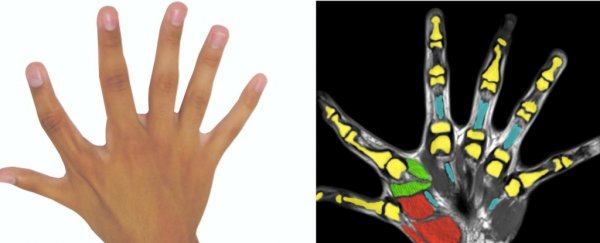It's really not uncommon for human babies to be born with extra fingers or toes. The mutation is called polydactyly, and around one in 500 babies has it. These extra digits are considered useless, and usually amputated not long after birth - but as new research has shown, they may not be quite so bad after all.
A new study of two people who kept their additional fingers - so they have six on each hand - has shown that they can type on their phones, play complicated video games, and even tie a shoelace all with just one hand.
As bioengineer Etienne Burdet of Imperial College London noted, "extra fingers and toes are traditionally seen as a birth defect, so nobody has thought to study how useful they might really be."
In some cases, the defect claim is true, since the extra digits can be vestigial, or poorly developed. But removing them isn't necessarily a simple procedure.
Each extra digit has its own bone structure, tendons, and musculature, all incorporated into the entire structure of the hand, so doctors don't just have to remove the extraneous part, but restructure the whole thing.
However, the new case study explores a different scenario. In the case of a 52-year-old mother and her 17-year-old son, the extra digits were well formed and fully developed. Both of them w3ere born with an extra finger between their thumb and index finger, on both hands.
This provided the research team with an excellent opportunity to answer some burning questions about polydactyly.
"First, is the movement of the additional finger actuated by other fingers' muscles, or does it have its own dedicated muscles and nerves?" they wrote in their paper.
"Second, how independent is the extra finger from the other fingers? Does its movement accompany the movement of common fingers, like in the little and ring fingers, or does it move independently from other fingers like the thumb?"
They also wanted to know if operating an additional, or supernumerary, finger on each hand made the brain work harder, to the detriment of cognitive function as a whole.
So, they devised a series of tasks to put the subjects' dexterity to the test. This included custom video games that used a standard computer keyboard, and object manipulation tasks, such as tying shoelaces, flipping book pages and folding napkins.
These were compared with 13 five-fingered controls performing the same tasks.

The researchers found that the polydactyl subjects were more dexterous than the five-fingered controls, able to move their supernumerary fingers independently of the others, with a thumb-like range of motion.
Scans revealed that these extra digits had three phalanges, like a finger does (while the thumb only has two), along with their own muscles, tendons and nerves.
And high-resolution functional magnetic resonance imagining (fMRI) while the subjects were performing the tasks revealed that the brain did work harder to manage the extra fingers - but, as far as the researchers could tell, to no overall cognitive detriment.
"The polydactyl individual's brains were well adapted to controlling extra workload, and even had dedicated areas for the extra fingers," Burdet said.
"It's amazing that the brain has the capacity to do this seemingly without borrowing resources from elsewhere."
Due to the limitations of the study, there is still a lot we don't know about manual polydactyly in general, though. Not all polydactyl infants have the extra finger between the thumb and forefinger, for instance, so it's unknown whether the position of the finger plays a role in the increased dexterity observed.
Nor is it known if it's isolated to fully developed supernumerary fingers; perhaps vestigial digits also confer a not-yet-known dexterity benefit.
"These superior abilities of our polydactyly subjects," the researchers wrote in their paper, "suggest to thoroughly evaluate the functionality of a supernumerary finger in polydactyly infants before deciding on whether to remove it."
The research has been published in Nature Communications.
